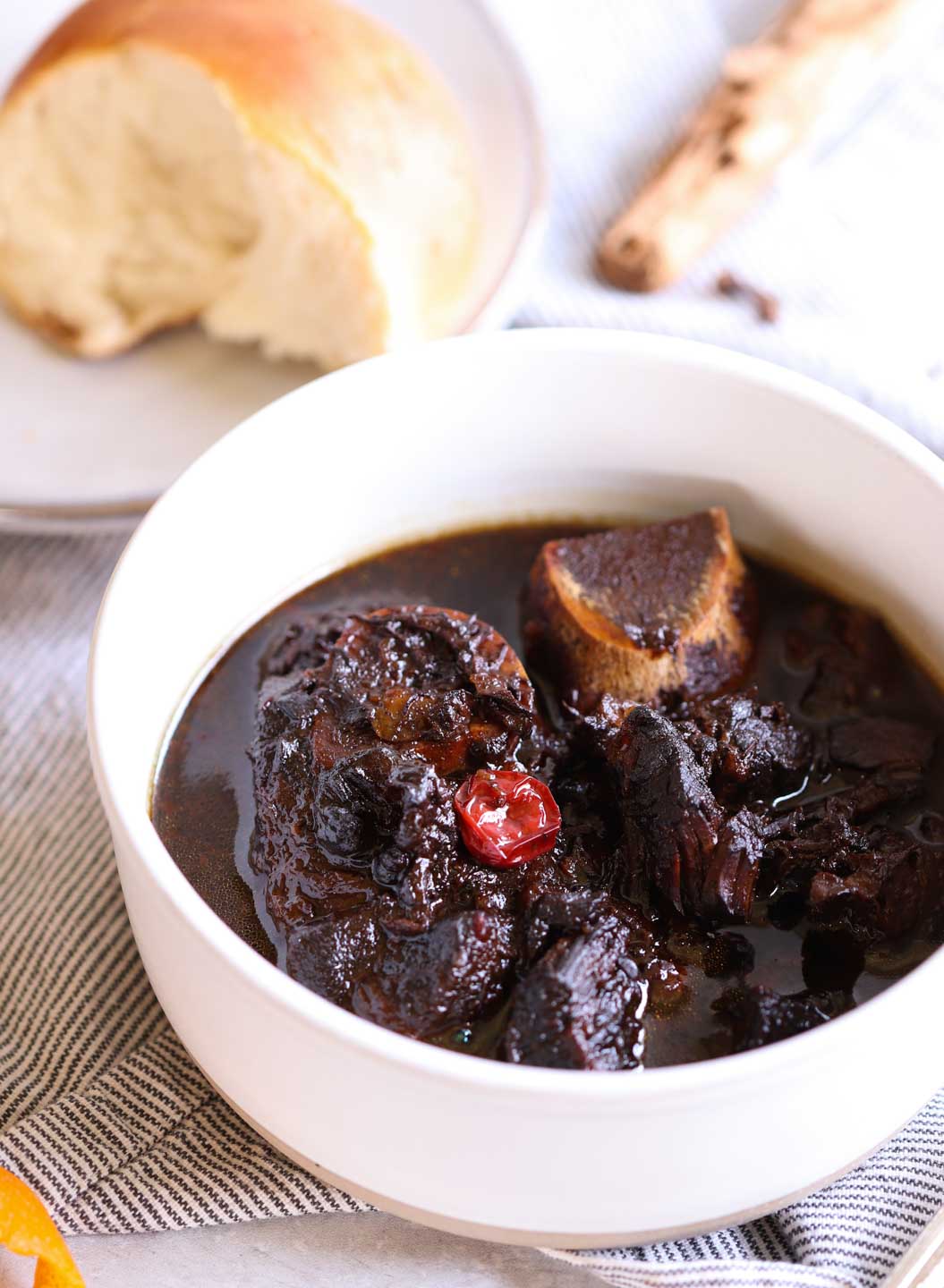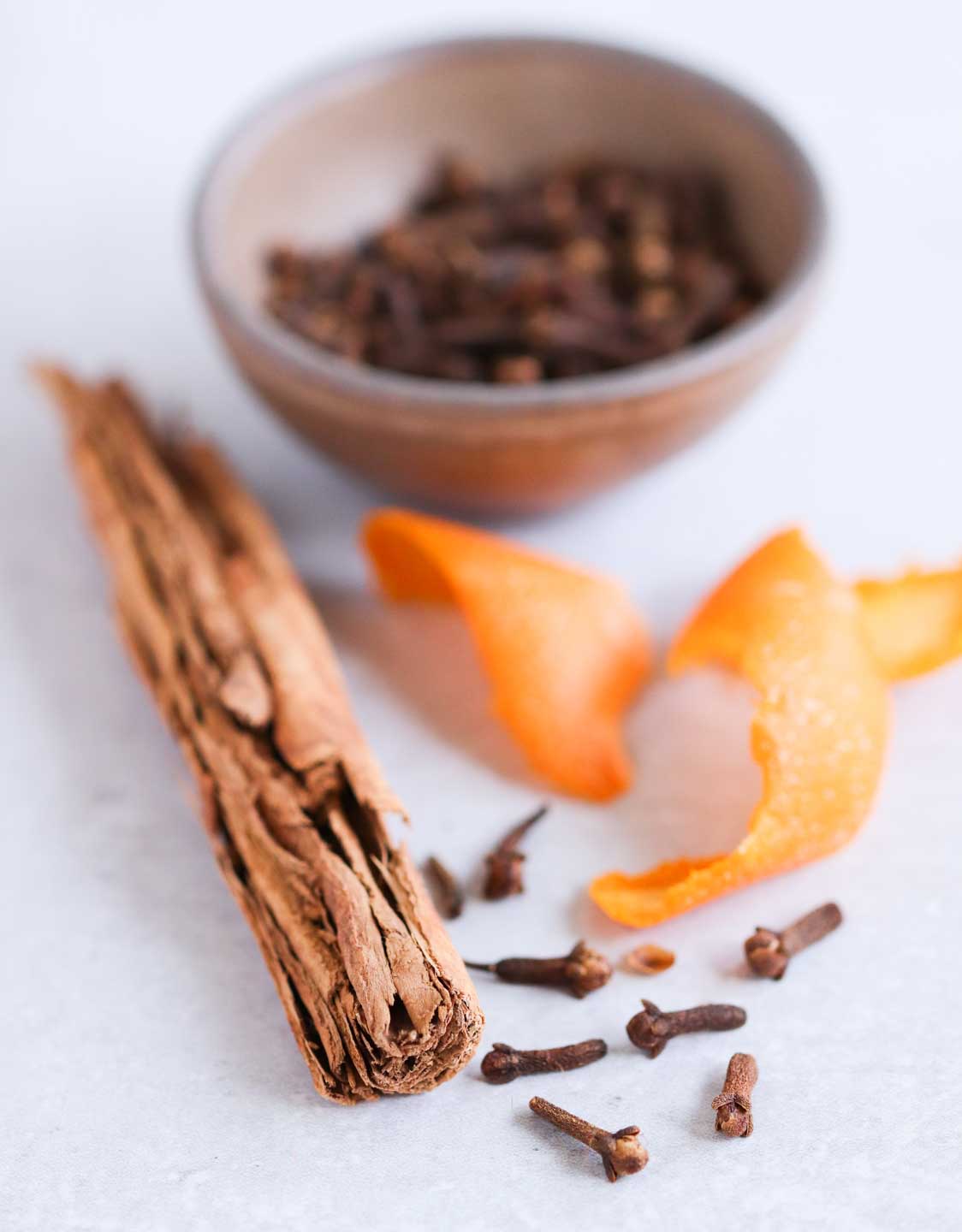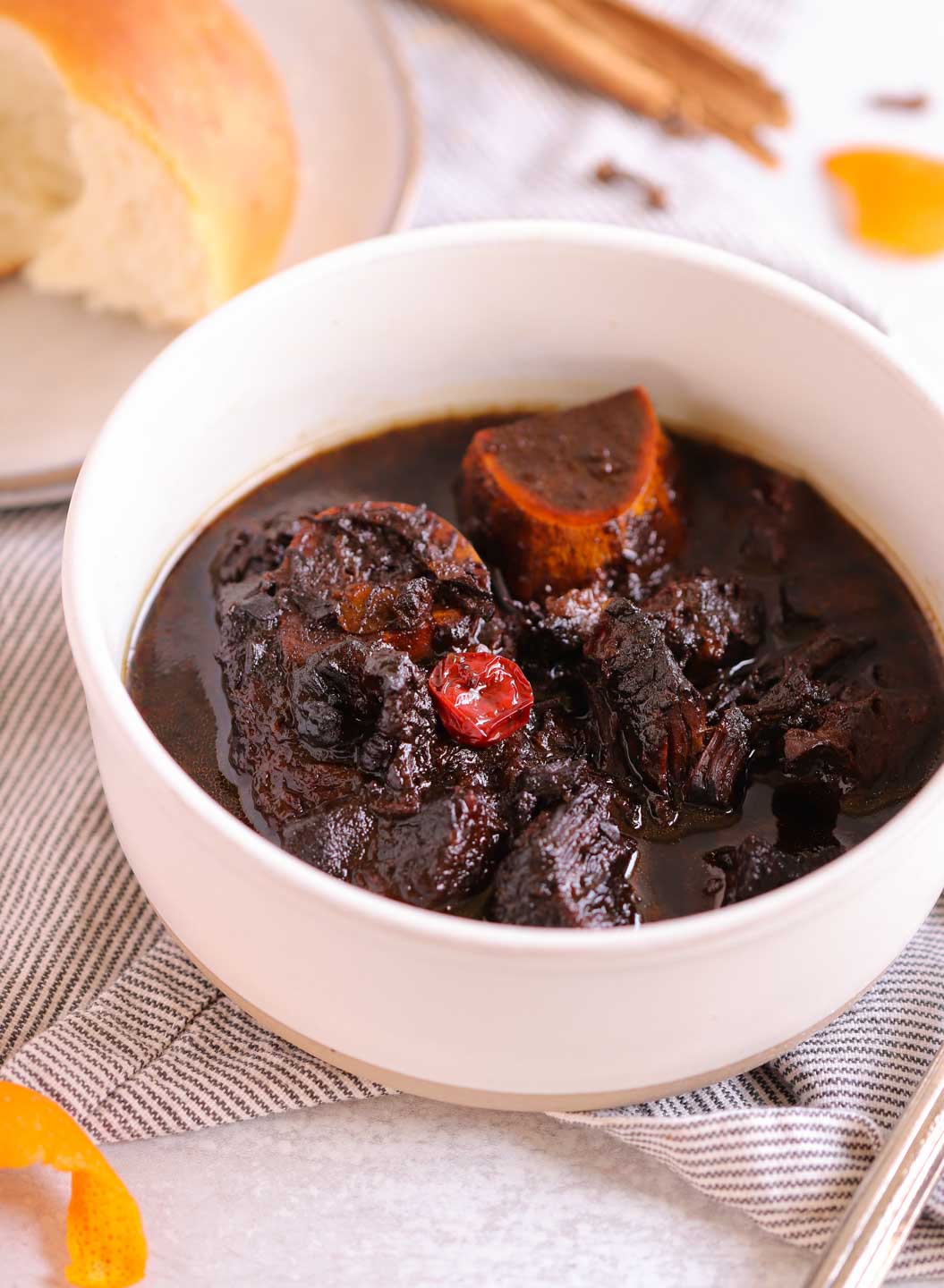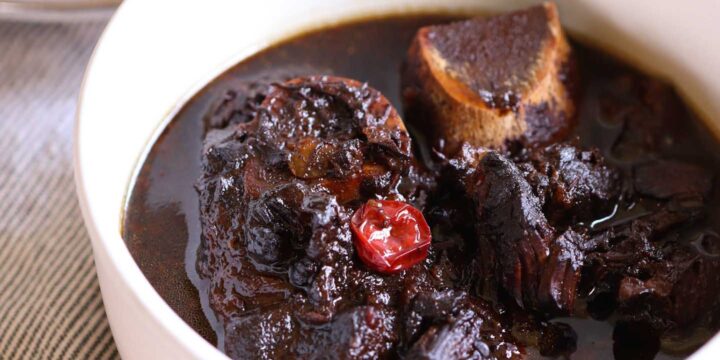Guyanese Pepperpot

Guyanese Pepperpot is a must have at Christmas in every Guyanese household. This hearty and aromatic stew has been an integral part of Guyanese cuisine, representing the diverse influences and traditions that shape the country’s gastronomy. As the national dish of Guyana, Guyanese Pepperpot embodies the techniques from indigenous Amerindians who used cassareep as a way of preserving meat.
Guyana, nestled on the northeastern coast of South America, is a melting pot of cultures. Its culinary landscape reflects the influences of indigenous Amerindian, African, Indian, Chinese and European traditions. Guyanese Pepperpot, which is a traditional dish, epitomizes this cultural fusion. Its origins can be traced back to the indigenous peoples of Guyana, who developed a cooking technique using cassareep—a thick, dark syrup made from cassava—to preserve meats. Over time, African, Indian, and European flavors and techniques were incorporated, creating the unique and complex flavor profile that defines Guyanese Pepperpot.
What is cassareep and how is it made?
Cassareep is made from cassava root, a staple crop in Guyanese cuisine. The process starts by peeling and grating fresh bitter cassava roots, which are then placed in a matapi. The grated cassava is squeezed to extract the liquid, which separates into two layers: a clear liquid on top and a thick layer of starch at the bottom. The clear liquid is carefully poured off and set aside for other uses. The cassava juice is then cooked in a pot over medium heat, continuously stirred to prevent sticking and scorching.
Through a slow and gradual reduction process, the liquid transforms into a thick and dark syrup known as cassareep. This cooking process not only thickens the liquid but also removes any toxins present in raw cassava, making cassareep safe for consumption. The resulting cassareep imparts a distinct flavor and color to dishes like Guyanese Pepperpot, adding depth and richness to the cuisine.

Essential Ingredients of this traditional Guyanese dish
To create the distinct flavors of Guyanese Pepperpot, several key ingredients are required. The foundation of this savory stew includes meat, such as beef, pork, lamb, cow foot or face, or even wild game meat such as labba. The star ingredient, cassareep—a thick, molasses-like syrup derived from cassava juice—offers a slightly sweet and unique flavor. The spice blend, featuring cinnamon, cloves, thyme, orange peel and wiri wiri peppers, adds a delightful kick that complements the rich flavors.
Slow Cooking for Maximum Flavor
The preparation of Guyanese Pepperpot requires time and patience. It is often slow-cooked in a large pot or Dutch oven, allowing the flavors to meld together beautifully. This slow simmering process tenderizes the meat, intensifies the flavors, and gives rise to the irresistible aroma that fills the kitchen. The result is a hearty and robust stew that is sure to tantalize the taste buds. This is typically made a day or two ahead to when it’s intended to be served as the flavor deepens the longer it sits.

What to serve with this dish
Guyanese Pepperpot is traditionally served on special occasions and holidays, such as Christmas and New Year’s Day. Traditionally it is eaten with cassava bread but at holidays it is essentially served with homemade bread. The deep, rich flavors of the stew and the tender meat accompanied with hearty homemade bread creates an exceptional dish. The sticky sauce clings to the bread which is typically soft, but firm enough to withstand the warm gravy. On less formal occasions it is enjoyed with rice or even roti.
How to store Pepperpot
What’s unique about this dish is that it requires no refrigeration. Because it uses cassareep, it preserves the meat. Simply bring to a boil daily, simmer for just a few minutes and this stew lasts for more than a week. Additionally, as needed, more meat can be added to the broth as well. Just ensure that it is thoroughly cooked.
Other Traditional Guyanese Christmas recipes:
- Plait Bread
- Aniseed bread
- Ginger Beer
- Sorrel
- Garlic Pork
- Black Cake
- Sponge Cake
- Fruit Cake
- Cheese Straw
Whether enjoyed during festive occasions or as a comforting meal on a chilly day, Guyanese Pepperpot never fails to satisfy and delight. So, grab a bowl of this flavorful dish, immerse yourself in the cultural journey it represents, and experience the taste of Guyana firsthand.

Get the Recipe GUYANESE PEPPERPOT
Ingredients
- 2 lb. pork, with bone, cut into pieces
- 2 lb stew beef, cut into 2 inch pieces
- 1 lb. cow foot
- 1/2 lb salted beef, cut into 2 inch pieces
- 4 salted pig tail, cut into 2 inch pieces
- 1 cup genuine cassava cassereep
- a few wiri wiri peppers or 1 scotch bonnet if you can’t fnd wiri wiri
- 4 cloves garlic
- 1 small onion
- 1 bunch thyme
- 1 teaspoon of salt, or salt to taste
- 3 tbsp sugar
- Lime juice or vinegar
- 4 cloves
- 2 pieces orange peel
- 1 stick cinnamon
Instructions
- Trim excess fat off meat and soak in vinegar for about 15 to 30 minutes. Puree garlic, onion and thyme. Marinate fresh meat with marinade and 1/3 cup of cassareep.
- Meanwhile, in a pressure cooker, place pickled pork and salted beef and pressure for a 10. Discard the water and set meat aside.
- Wash cow foot thoroughly by soaked in vinegar for about half an hour. Rinse. Place in pressure cooker and pressure for 20 minutes or until tender. Discard water. *If the cow heel isn’t soft after 20 minutes, continue to pressure in 5 minute intervals , checking for tenderness.
- In a stock pot, cook beef and pork in marinade until all liquid evaporates. Add the cow foot, pickled pork, salted beef, sugar and remaining cassereep with a stick of cinnamon, cloves, orange peel and enough water to cover. If the stew is brown, add more cassareep to attain a deep, dark color.
- Cook slowly until tender. Add pepper and salt to taste. This meal tastes better the next day, so it is best when made a day ahead. To serve this meal, warm and serve with bread.
Video

Slightly different from my recipe but sounds just as delicious!
Drinking wine sounds perfect to me, happy holidays to you = )
Hi Jehan,
I wanted to wish you Merry Christmas, I hope Santa was good to you this year 🙂 Your pepperpot looks delicious! I put up my dads recipe as well on my blog. Its so strange how everyone makes pepperpot differently, but no matter what its a must have on Christmas morning!
Alica
Merry Christmas to you too! I hope you had a wonderful Christmas as well. I just check out you recipe and I didn’t use any orange peel in mine because I forgot to buy lol. And I just realized I forgot to add the clove and orange peel to the recipe…oops lol. Good thing I checked out your blog. I will update my recipe and add cloves and orange peel. I hope you enjoy the rest of your holidays.
I would loveto have the recipe for the bread. I love the pepper pot.
I will have to ask my mom for that bread recipe, but this year I made a challah and it was great with the pepperpot! It was sturdy enough to withstand the pepperpot without falling apart.
Why are you discarding the water? That is the best part of the flavor…
Is there a recipe for the cassava bread?
No I don’t have a cassava bread recipe.
Can you please Share your recipe for your mom bread, it reminds me of guyana bread.. look so yummy …thank you… Anita:)
Hello there Jehan! Thank you so much for this recipe!
My boyfriend is Guyanese and I’ve been trying to surprise him with Pepperpot for a while now. But, he doesn’t eat pork and he just gave up red meat. Pepperpot is his absolute favorite. Is there an alternative meat, like chicken, that I can use instead of red meat?
Thank you so much!
Hi May, I’ve never had properly with chicken or heard of it being made that way . I don’t think that it will be remotely close to the traditional .
Hello there! I’m late to this party but I’m delighted to find you. I’ve just been sampling my mum’s pepperpot in advance of tomorrow’s Christmas breakfast. I also had my first garlic pork of the season earlier – just to sample it you understand.
Anyway, I showed your recipe to my mum, it is not entirely the same as hers but it meets with hearty approval. Mum even confessed that her own recipe should contain salted pig tail but she can’t always get it.
Enjoy that praise – it doesn’t happen often, but then again a good cook would recognise another.
Happy Christmas!
Can I use pigs foot and if so what should I do prior to adding it to the pot?
Yes you can, and you have to boil it separately as well before adding.
Hi there
I just finish my moms xmas pepperpot promising once again that i will learn to make it myself this year. My son is really on my back about this so I will give you recipe a try this weekend Jehan.
Re: chicken pepperpot..i had this in Guyana this past august. I and a mixed group of guyanese and non-guyanese with particular dietery restrictions visited an ameri-indian village on an island the essiquibo and requested ahead of time that the pepperpot be chicken only. it was nice but i must admit did not taste anywhere near like a traditional pepperpot. it wasn’t bad just different. I think they skimped on the pepper and some spices too cuz it wasn’t so dark or spicy as traditional pepperpot. but they were trying to accomodate our guests so that why i think. It was also served with cassava bread which i’m not a fan of. If you use the traditional spices it should still be good but like Jehan said not quite like the traditional version.
Pingback: Pepper Pot and Artisan Bread | Levain Diplomacy
Hi Jehan, I am new to your site and I absolutely love it. You certainly know your cultural foods :), I’m Guyanese by the way! Concerning the chicken as a substitute for the other meats in pepper pot, I must say for a fact it is very much doable. You have to use the boney parts of the chicken for the most part (back, thigh,drumsticks wings and neck), and of course the feet to give it that jellylike effect of the cow’s feet. With all the seasonings just like in your recipe and genuine casserip, I have to say it makes for a pretty good substitute on Christmas morning!
Barbara thanks for the tip. I can see how the chicken foot could be a great substitute for the cow’s feet. I will have to try this one day for the sake of adding a different version for non pork and beef eaters. Thanks.
Jehan thank you so much for sharing your recipes! the ones I have tried are wonderful! I cant wait to try the pepperpot this Xmas. Thank you and God Bless!
Hi Jehan your picture of your moms baked bread is beautiful. I would like to try this for my Christmas morning, can you please share the recipe ?
Hi Dara, here’s the recipe for the bread. https://jehancancook.com/?p=3536
That dish looks so yummy!
Hi Jehnacancook, can you please post a recepie for lamb pepper pot?
Patiently waiting for that recepie.
Thank you 🙂
Priya, simply substitute lamb instead of the meats I’ve used.
One of my favorites. Christmas really isn’t the same without it. I made this for my boyfriend and family. Followed your recipe completely with an addition of oxtails (the meat I grew up having). It was my absolute first attempt and it came out wonderful. My boyfriend said it’s the best he’s ever had and he’s an uber foodie so he’s tried quite a few. Oh I made your plait bread also. Perfect. You’ve made me a better cook. Thank you
Thanks Melly, I’m glad you enjoyed it.
Hi Jehan. Thanks for this recipe. As it’s nearly Christmas, I wanted to try this recipe. It was very easy to follow. I did substitute the salted pork for spare ribs and I omitted the cow foot. But it actually turned out delicious. I made some bread too which is equally as nice. Thanks again
Hi Jehan!
Thanks so much for posting. This is my Christmas gift to my dad who hasn’t had a pepperpot (much less decent) for at least 20 years. As first Gen north American, I think he will be proper pleased with his children keeping with tradition. Thanks for sharing so I could share such fond memories with my daddy as well! Merry Christmas gal!
Great site! Jehan where can I find cassareep in Atlanta!?
Nikki, Georgetown Food Market carries cassareep. There are two locations, one in Decatur and a second in Jonesboro.
Hey JehanP ,
I really love your blog and the recopies on here . Someone asked about using other meats instead of the traditional used in the pepper pot . I would recommend lamb and/ turkey . I’ve personally tried the two and I must say they both worked well !
Hi Dacy, thank you for the kind words. I will have to give that a try!
Found your recipe last christmas as we couldnt find my mothers we used yours.we are definitely related.no way could it be like my mothers without that connection.we are in north london.england and guyanese.
Thanks for the recipe. I can’t wait to try it. I have just one question; do you pickle both the pork and stew beef at the start or just the pork? Thanks again
Hi Lau, the pickled pork is referring to the salted pigtail. It is bought already salted and pickled. Sorry for the misunderstanding.
I have yet to try this version of Pepperpot as no way to find that here in PA. I’ve been wanting too for a long time but such things not easy to find here. I have to order it from Amazon most likely. But can you recommend a good brand of Cassareep that you know of so i get the real thing because i know there are quite a few on Amazon.
Hi Jehan,love your site.I can’t get pig tail or salted beef what could I use as a substitute please?
Hi Roz, you can substitute with any salted meat but if not, just omit it from the recipe.
Does it have to done in a pressure cooker? Or can I cook it in a pot for a longer time?
It doesn’t have to. A pressure just cuts the cooking time. You can boil it but it will take more than an hour.